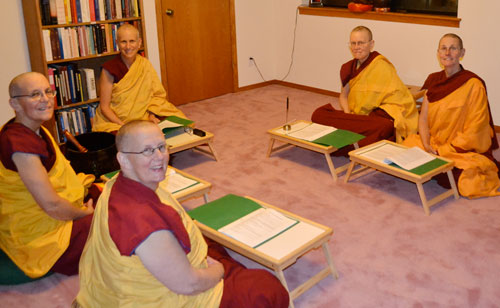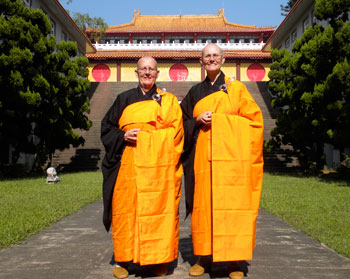
Sravasti Abbey bhikshuni sangha begin their first official posadha, or confession ceremony. Clockwise from top, beginning in the center, they are abbey founder Ven. Thubten Chodron, Ven. Thubten Tarpa, Ven. Thubten Chonyi, Ven. Thubten Jigme, and Ven. Thubten Semkye.

Five Fully Ordained Nuns at Sravasti Abbey Build Foundation for Dharma Here
Incense perfumed the air, an offering for the 14,000 Buddha images that line the walls of the Great Hall. I stood with about 200 hundred other women and 50 men, all dressed in graceful dark robes, in impeccably straight rows. Ven. Jigme stood two people behind me, the only Caucasians in a sea of Chinese.
Heads up and eyes lowered, we chanted the Chinese homage to Shakyamuni Buddha—namo ben shi shi jia mou ni fo—to the rhythmic “tok” of a wooden “fish,” all minds intent during Fo Guang Shan monastery’s full ordination program.
What were two English-speaking American nuns in the Tibetan tradition doing in Fo Guang Shan, a Chinese monastery in Taiwan, having no background in the language, culture, or even that particular form of Buddhist practice?
In November we joined the rigorous four-week program to receive the 348 precepts of a bhikshuni, a fully ordained nun. “I have a very strong motivation to use this life to progress as far as I can on the Buddhist path,” Ven. Jigme explained. “For me, the monastic precepts are like a road map and a protector on the journey to awakening.”
Beyond furthering our personal spiritual aspirations, our ordinations are significant for several reasons. Sravasti Abbey—our home monastery in Newport, Wash., 50 miles north of Spokane—now has five fully ordained nuns; thus we become a fully functioning monastic community according to the Vinaya. This allows the community to enact several practices that the Buddha prescribed, which will have the long-term effect of helping to root the dharma in American and in the West.
Further, the abbey is likely the only sangha of fully ordained bhikshunis practicing in the Tibetan tradition in the U.S. In fact, there are few such communities in the world.
Because full ordination is not available for women in the Tibetan tradition, Ven. Jigme and I, and other Tibetan Buddhist nuns who seek bhikshuni ordination, receive ordination in the Dharmagupta Vinaya practiced in the Chinese, Korean, and Vietnamese traditions.

Vens. Jigme and Chonyi in their Chinese bhikshuni robes at Fo Guang Shan monastery in Taiwan.
Possibly because of dangerous travel conditions, the bhikshuni lineage was not established in Tibet. However, the bhikshuni sangha thrived in China. In Taiwan, where mainland monastics fled to escape the communist takeover, bhikshunis make up roughly three quarters of the monastic population. All the Sravasti Abbey nuns take their novice ordinations at the abbey and then take bhikshuni ordination in Taiwanese temples.
Having five fully ordained bhikshunis also opens the possibility for the abbey to conduct full ordinations in Washington in the future, when all the conditions come together and resident monastics have attained five to 10 years of seniority.
According to the Vinaya, the rules for Buddhist monastics, 10 fully ordained senior nuns and 10 equally qualified monks—or five each in outlying areas like the U.S.—are required for the bhikshuni ordination to be given. Bhikshus, fully ordained monks, receive ordination only from the sangha of monks.
Perhaps the most significant impact of our ordinations is the least publicly visible. Having at least four fully ordained monastics allows Sravasti Abbey to conduct three specific activities, or sanghakarmans: a twice-monthly precept confession and restoration ceremony, an annual rains retreat, and a ceremony to conclude the rains retreat. These form the basis of a living Vinaya tradition.
The confession ceremony, posadha, reminds monastics of their values and gives us the opportunity to restore broken precepts. This regular self-examination helps us maintain a high standard of ethical conduct, creating a firm foundation for developing concentration and wisdom, and providing a valuable model for society.
“To spread the entire Buddhist path, all three ‘baskets’ of teachings—Vinaya, Sutra, and Abhidharma—must be taught and practiced,” said Bhikshuni Thubten Chodron, the founder of Sravasti Abbey. “In particular, the Buddha stated that the dharma flourishes where the Vinaya—the monastic discipline—is a living tradition.”
The Buddha taught the necessity of nurturing the four-fold sangha: male and female lay practitioners, and fully ordained monks and nuns.
“It”s not just the existence of individual practitioners that is important,” Ven. Chodron said. “A community of four or more fully ordained monastics is crucial for the flourishing of the Buddha”s doctrine.”
Ven. Chodron received novice ordination in India in 1977 and trained with Tibetan Buddhist masters, including His Holiness the Dalai Lama. She soon discovered that some opportunities, such as full ordination, were not available to her as a woman.
She recalls, “We heard about nuns in Taiwan. They were fully ordained, well-educated, and carried responsibilities equal to the monks. A few of us Western nuns were interested in receiving full ordination in order to train our minds in this way.”
In 1986 she revealed her bhikshuni aspiration to His Holiness the Dalai Lama. “I’ll make prayers for you,“ he replied. And so, with the blessings of her teacher, she traveled to Taiwan to take full ordination.
In recent years there has been interest in bringing bhikshuni ordination into the Tibetan tradition, which His Holiness supports, but the process has been slow. In the Theravada tradition of Southeast Asia, where the bhikshuni lineage thrived for hundreds of years before dying out completely around the 11th century, a revival has begun. Through expanding opportunities for full ordination, nuns can begin to take a more equal role in Buddhism, an unquestionable benefit to our global society.
“By taking bhikshuni ordination,” said Ven. Chodron, “we assume the responsibility to continue the Buddha’s teachings in the same complete way that they have been passed down to us.” This sense of responsibility led to her establishing Sravasti Abbey in 2003, which became one of the first monasteries in the U.S. to train and support Western monastics in the Tibetan tradition.
“I recently met with His Holiness,” Ven. Chodron said. “He was very pleased to hear that we have five bhikshunis ordained in the Dharmagupta Vinaya tradition.”
Men have been slower to ordain at the abbey, but we look forward to the day when we can also announce the presence of four fully ordained monks.
Taiwanese have assisted greatly in the growth of Sravasti Abbey—including helping to ordain novice monastics—and Ven. Jigme and I treasure the training we received at Fo Guang Shan. Still, at the end of the program we were happy to exchange our elegant Chinese robes for the familiar maroon Tibetan ones.
Historians say it takes 300 years for the Buddhadharma to take root in a new region. The first known American refuge ceremony took place in 1893, so we’re barely a third of the way there.
The ordained sangha at Sravasti Abbey will contribute by doing our best to uphold the Vinaya and by spreading the dharma. We are growing a harmonious community that also welcomes lay guests who want full immersion into a spiritual life, short-term or long-term. In this way we are further grounding the four-fold sangha in American soil.
For more information on Sravasti Abbey and Buddhist monasticism visit sravasti.org and the monastic life section at thubtenchodron.org.
About the author:
Thubten Chonyi began her dharma study with Ven. Thubten Chodron at Dharma Friendship Foundation in Seattle in the mid-1990s. She took novice ordination at Sravasti Abbey in 2008, and received bhikshuni ordination in November 2011.
Photos courtesy of Sravasti Abbey